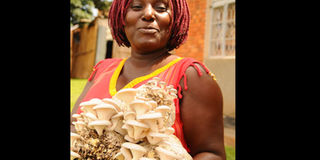Marketer leads the way with mushrooms

Connie Rutabingwa displays mature mushroom Photos by Derrick Wandera
What you need to know:
Although the venture is lucrative and has the potential to change one’s fortunes, it has some challenges that one has to deal with, writes Derrick Wandera.
She graduated from Makerere University Business School (MUBS) with a Bachelor of Business Administration in Marketing.
But instead of applying her skills in the labour market, Connie Rutabingwa, 33, is busy getting her hands dirty.
Farming is an innate desire and she has no choice but to divide her time between the job she studied for and the passion.
Rutabingwa who in 2009 established her farm in Ntinda a Kampala upscale suburb, tells Seeds of Gold more about herself and the mushroom farming she has established.
“I am not a full time mushroom farmer. I also do consultancy in Kampala, but farming is what I enjoy more,” says Rutabingwa.
“I opted for mushrooms as it is not a common crop, hence the market is available and the returns are way better than other crops.”
Starting
“Starting up the mushroom business was devastating, it required a lot of money and that meant I had to put in all my savings,” she says.
Armed with a capital of Shs1.5m, she ventured into button mushroom farming in September 2009, after seeking training from a man who had grown mushrooms for four years.
“It was a rough journey at the beginning. Along the way I met several hardships such as cheats who sold me fake planting materials,” says Rutabingwa.

Rutabingwa looks on as a worker heats spawn. Spawn is planted after heating.
Process
She explains to Seeds of Gold, some of the processes that go into mushroom farming.
First you prepare substrate.
This involves mixing chicken manure, molasses, sunflower, urea, gypsum and lime. After that, she says, the substrate is pasteurised.
Spawning follows pasteurisation. It is a process which involves putting spawn in the ready substrate.
Packaging is the next step and then storage, which involves putting in dark cool room.
This is followed by colonisation (spreading seeds in the bags).
“When this is done, level the top of the bag and add virgin soil that has been treated. Now you can wait for them to mature,’’ she says.
Challenges
Rutabingwa carries out all these in a thatched house, measuring 12ft by 18ft, next to where she lives.
Although the venture is lucrative and has the potential to change one’s fortunes, it has some challenges that one has to deal with.
These include diseases which affect the crop and the yields. “Green and white mould is the most common disease,’’ she reveals.
She adds that another challenge is that it is a capital intensive venture. Rutabingwa also says that at times, it is hard to find the spawn.
Despite the many hurdles, she has never regretted venturing into the business.
“I have no regrets at all. I wish I had started earlier,’’ she says. The farmer says that one ought to harvest the mushrooms daily or at a period not beyond 36 hours.
However, the quantity of the yields depends on the number of packaging bags used. She harvests between 50 and 100 kilogrammes per week and sells each at a price ranging from of Shs10,000 to Shs20,000.
She hopes to do value addition in future. “My plan is to start packaging and exporting mushrooms and sell them in powder form.”
About mushrooms
Mushrooms have great health and medicinal benefits. Their benefits are the same as those of fruits and vegetables as they are rich in proteins, valuable minerals, vitamins and fibre.
They are also low in calories, have no cholesterol and are virtually free of fat and sodium.
Mushrooms are highly-recommended for diabetes and heart patients because of their high protein and low calorie content.
They are also the diet of choice for those suffering from or are prone to obesity and arteriosclerosis.
All the essential amino acids required by an adult are present in mushrooms.
Early steps
• You will need a spawn to start the culture. You can produce your own spawn using a sterile culture. You will also need to buy the substrate. Many farmers use the mixture of chicken manure, sunflower and molasses.
• First mix the chicken manure, sunflower and molasses. Next, wet the mixture. Now it’s time to heat the mixture in boiling water. Continue boiling for half an hour and then remove and drain it. Next, spread out on a clean surface and let it cool down.
• Now it is time to pack plastic bags with the cooled mixture and spawn. Pack two or three inches of mixture into the plastic bag and then lightly sprinkle the spawn on top. Repeat this until you have almost filled the bag, close the top and poke holes in the bag.




